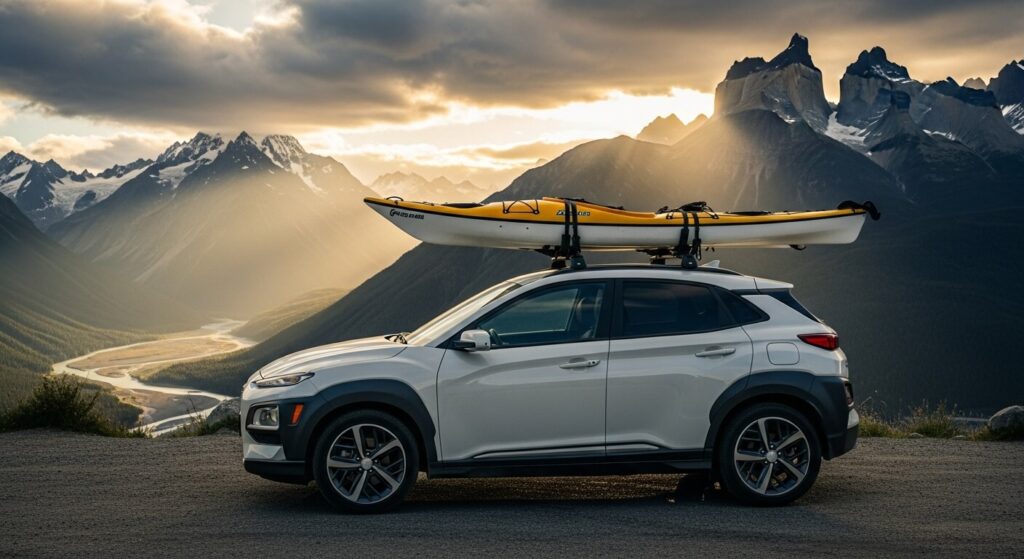When you drive a Hyundai Kona, space is already at a premium, so finding the best kayak rack isn’t just about convenience, it’s about making sure you can actually haul your gear without stress. A rack has to be sturdy, easy to mount, and gentle enough on the car’s compact roofline. After checking through options, reading user experiences, and considering weight capacity against the Kona’s build, one product really stands out. The FORWODE Premium Kayak Roof Rack earns the top spot for its reliable fit, aerodynamic shape, and the way it balances strength with ease of loading. If you want a setup that saves time and avoids headaches, this rack is the clear winner.
Best 5 Kayak Racks for Hyundai Kona
01. FORWODE Premium Kayak Roof Rack
The FORWODE Premium Kayak Roof Rack is built for paddlers who want a strong, no-nonsense setup for carrying kayaks, canoes, or even small boats on SUVs, trucks, or crossbars. Made with heavy-duty steel and padded J-cradle arms, it keeps your kayak snug without scraping or shifting during highway runs or bumpy backroads. It’s designed to fit most factory and aftermarket crossbars, so whether you’re driving a Ford Explorer, Toyota 4Runner, Subaru Outback, or Chevy Silverado, this rack makes loading simpler and hauling safer. With easy installation and fold-down arms, it saves space when not in use.
Pros:
- ✅ Heavy-duty steel frame for durability
- ✅ Foam padding protects kayak hulls from scratches
- ✅ Fits round, square, and aero crossbars on SUVs & trucks
- ✅ Foldable design for garage clearance & storage
- ✅ Works for kayaks, canoes, and paddleboards
Cons:
- ❌ May require extra straps for long highway trips
- ❌ Not ideal for extremely wide fishing kayaks
- ❌ Slightly heavier compared to aluminum racks
02. SLSWHLX Direct Aftermarket Universal Kayak Rack
The SLSWHLX Direct Aftermarket Universal Kayak Rack is built for paddlers who want an affordable way to haul their kayaks, canoes, or small boats on SUVs, trucks, and cars with crossbars. Made with steel construction and padded support, it helps secure watercraft without scratching the hull. This universal kayak carrier fits most factory and aftermarket roof rack systems, making it a reliable option for outdoor trips, fishing excursions, or weekend lake getaways.
Pros ✅
- ✅ Fits most crossbars (round, square, oval, and flat)
- ✅ Sturdy steel design with foam padding for hull protection
- ✅ Works for kayaks, canoes, and small boats
- ✅ Simple installation with included hardware
Cons ❌
- ❌ May require extra straps for long-distance travel
- ❌ Padding can wear out with frequent heavy use
- ❌ Limited clearance for very wide kayaks
03. GZDEMYYXGS Folding Kayak Roof Rack
The GZDEMYYXGS Folding Kayak Roof Rack is built for paddlers who need a strong and practical way to carry kayaks, canoes, or even surfboards on their car roof. Its folding J-bar design makes loading simpler while also allowing you to keep it low-profile when not in use, avoiding extra wind resistance. The heavy-duty steel frame, padded cradles, and adjustable straps help secure different kayak types—whether you’re hauling a fishing kayak, touring kayak, or sit-on-top style. Compatible with most crossbars, this rack is aimed at SUV, truck, and sedan owners who want reliable kayak transport without fuss.
Pros ✅
- ✅ Sturdy steel construction with rust-resistant coating
- ✅Foldable design saves space when not in use
- ✅Thick foam padding reduces scratches on kayak hulls
- ✅Fits round, square, and factory crossbars
- ✅Works for kayaks, canoes, paddleboards, and surfboards
Cons ❌
- ❌ Straps included may not be heavy-duty enough for all kayaks
- ❌ Installation can take longer the first time
- ❌ May not fit some wide aero-style crossbars
04. Yima Kayak Roof Rack
The Yima Kayak Roof Rack is built for paddlers who need a solid way to transport their kayak, canoe, or SUP board without fuss. Designed with heavy-duty steel and padded J-bar cradles, it fits most factory and aftermarket crossbars, making it a versatile option for SUVs, trucks, and cars. The rack helps keep your boat secure on highway trips while protecting the hull from scratches and dents. Outdoor enthusiasts looking for a reliable kayak carrier will find it useful for weekend lake trips, river runs, or coastal paddling.
Pros ✅
- ✅ Heavy-duty steel frame for durability
- ✅ Foam padding to protect kayak surface
- ✅ Fits round, square, and flat cross bars
- ✅ Space-saving J-style design allows multiple racks
Cons ❌
- ❌ May require tools for installation
- ❌ Straps could be sturdier for rougher roads
- ❌ Not the best fit for very wide fishing kayaks
This kayak roof rack works well with both recreational and touring kayaks, and it’s compatible with common brands of crossbars like Thule, Yakima, and Rhino-Rack. For families or solo paddlers, it’s a practical choice that balances affordability with function. The compact J-style makes loading easier compared to flat saddles, especially when lifting boats onto taller vehicles. If you’re comparing kayak carriers for SUVs, sedans, or pickup trucks, the Yima Kayak Rack should be high on your list for safe transport and ease of use.
05. Malone Downloader 2-Pack Roof Rack
The Malone Downloader 2-Pack Roof Rack is a solid choice for kayakers looking for a reliable J-style carrier that works with most factory crossbars and aftermarket roof racks. Built with sturdy corrosion-resistant steel and fold-down design, it makes hauling multiple kayaks, canoes, or small boats easier without eating up too much roof space. The package also includes SpeedLine ratchet tie-downs, making the loading process secure and faster for highway travel or long trips. This rack is particularly useful for SUVs, trucks, and crossovers that need compact yet dependable kayak transport.
Pros:
- ✅ Universal fit for most crossbars
- ✅ Fold-down design for garage clearance
- ✅ Includes ratchet tie-downs for secure hauling
- ✅ Durable steel with corrosion-resistant coating
Cons:
- ❌ Bulkier than low-profile roof racks
- ❌ May require extra padding for fiberglass kayaks
- ❌ Installation can be tricky for first-time users
How to Choose The Best Kayak Racks for Hyundai Kona
The first time I strapped a kayak onto a compact SUV, it looked like a drunk spider had tied the knots. Ropes everywhere, nothing secure, and the whole drive I was imagining the boat cartwheeling down the highway. So yeah, I learned fast: the rack matters. Especially with something like a Hyundai Kona, which is not a hulking pickup but a small-ish crossover trying to balance style and practicality.
The roof itself is not that wide
Hyundai Kona roof width is around 70.9 inches overall, but the actual usable roof area where a rack sits is smaller, closer to about 43 inches between roof rails on most models (if you have the rails). That size limitation means you can’t just toss on some gigantic universal system and hope it fits. A lot of people buy J-style kayak carriers because they angle the kayak up on its side, saving roof space. One car rack company measured that a J-cradle can free up about 25% more roof space compared to a flat saddle mount. It matters because the Kona is squat and narrow compared to something like a Subaru Outback.
I once saw a guy force two kayaks on a Kona with foam blocks and ratchet straps. It technically held. But his paint job… not so lucky.
Factory rails or not?
Some Konas come with factory-installed side rails. Some don’t. This detail changes everything. If your Kona doesn’t have rails, you’re either buying clip-on crossbars that hook into the door frame (not my favorite, they creak and whistle at high speed), or you pay a bit more for aftermarket raised rails and then attach real crossbars.
Crossbars, by the way, need to support the weight of a kayak. Average kayak weight: anywhere from 35 lbs (short sit-on-top) to 80 lbs (long touring). Add wet gear and straps, call it 90 lbs max. Most aftermarket crossbars for the Kona can hold around 150 lbs dynamic weight (while driving), so technically you’re fine. But cheap bars flex. And when you see your boat bouncing like a trampoline on the interstate, you’ll start sweating.
J-cradles, saddles, or stackers?
There’s this endless debate. Here’s the messy breakdown:
- ✅ J-cradle racks: Kayak sits at an angle. Works well for narrow roofs. Easy to load if you’re tall-ish. Bad news if you’re short, because lifting an 80 lb kayak up and sideways feels like a CrossFit nightmare.
- ✅ Saddle-style racks: Kayak sits flat, hull down. Very secure, better for long drives. But eats up all the roof space, meaning one boat max.
- ✅ Stackers: Upright vertical posts that let you strap multiple kayaks side by side. Fine for whitewater boats (they’re shorter, lighter), but on a Kona? I’d call it optimistic at best.
For me, the J-cradle wins for the Kona. It’s compact, efficient, and honestly looks less awkward than balancing a giant plastic banana flat across the roof.
Loading struggles nobody talks about
Here’s the kicker: it’s not about the rack, it’s about you lifting the thing up there. The Hyundai Kona roof height is around 61 inches. Add the rack and cradle, you’re hoisting maybe 70 inches. If you’re under 5’7, you’ll be balancing on your tire or carrying a stool in your trunk (yes, I’ve done that). Some racks come with load-assist arms that swing down and let you push the kayak up with less drama. Thule Hullavator is the classic, but it costs almost half of what some people pay for the car itself.
Cost reality check
Quick scan of the market:
- ✅ Cheap foam blocks: $30 to $50. Temporary, not pretty, not long-term safe.
- ✅ Mid-tier J-cradles (Yakima JayLow, Rhino-Rack): $150 to $250. Decent.
- ✅ Premium with load-assist (Thule Hullavator Pro): $650 to $700. Painful on the wallet but makes solo loading feasible.
And yes, you’ll also need crossbars if your Kona doesn’t already have them, which is another $200-$400 depending on brand. By the time you’re “done,” your $200 kayak is riding on $800 worth of metal.
Wind drag and gas mileage
This one sneaks up on people. Adding a kayak rack plus the kayak itself can drop your MPG by 15–20% at highway speeds. It’s not a small thing when the Kona already averages around 30 MPG combined. I noticed with two boats on top, my tank ran dry faster than my patience in Friday traffic. You can feel the drag. It hums.
Personal quirks and mistakes I’ve seen
- ✅ Ratchet straps that cut into the kayak because someone pulled them tight as guitar strings.
- ✅ Forgetting a bow and stern tie-down. Trust me, crosswinds will make you regret it.
- ✅ Borrowing bungee cords from the garage. Please no.
So what’s “best” then?
If I had to give a straight answer (and I really don’t like giving straight answers), I’d say:
- ✅ If you have one kayak and don’t want headaches: J-cradle, mid-range brand, proper crossbars.
- ✅ If you’re hauling heavier sea kayaks or doing road trips often: Saddle or assisted loader, spend the money.
- ✅ If you’re the “I’ll try anything once” type: foam blocks, but accept scratches and chaos.
Every setup has trade-offs. No single rack is magic. You sort of… live with what annoys you the least.






